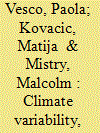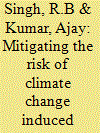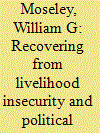|
|
|
Sort Order |
|
|
|
Items / Page
|
|
|
|
|
|
|
| Srl | Item |
| 1 |
ID:
178649


|
|
|
|
|
| Summary/Abstract |
Although substantive agreement exists on the role of climate variability and food scarcity in increasing violence, a limited number of studies have investigated how food resources affect violent conflict. This article explores the complex linkages between climate variability, agricultural production and conflict onset, by focusing on the spatial distribution of crop production in a cross-country setting. We hypothesize that spatial differences in crop production within countries are a relevant factor in shaping the impact of climate variability on conflict in agriculturally -dependent countries. To test this hypothesis, we rely on high-resolution global gridded data on the local yield of four main crops for the period 1982–2015 and aggregate the grid-cell information on crop production to compute an empirical indicator of the spatial concentration of agricultural production within countries. Our results show that the negative impacts of climate variability lead to an increase in the spatial concentration of agricultural production within countries. In turn, the combined effect of climate extremes and crop production concentration increases the predicted probability of conflict onset by up to 14% in agriculturally dependent countries.
|
|
|
|
|
|
|
|
|
|
|
|
|
|
|
|
| 2 |
ID:
110809


|
|
|
|
|
| Publication |
2012.
|
| Summary/Abstract |
Despite many claims by high-ranking policymakers and some scientists that climate change breeds violent conflict, the existing empirical literature has so far not been able to identify a systematic, causal relationship of this kind. This may either reflect de facto absence of such a relationship, or it may be the consequence of theoretical and methodological limitations of existing work. In this article we revisit the climate-conflict hypothesis along two lines. First, we concentrate on indirect effects of climatic conditions on conflict, whereas most of the existing literature focuses on direct effects. Specifically, we examine the causal pathway linking climatic conditions to economic growth and to armed conflict, and argue that the growth-conflict part of this pathway is contingent on the political system. Second, we employ a measure of climatic variability that has advantages over those used in the existing literature because it can presumably take into account the adaptation of production to persistent climatic changes. For the empirical analysis we use a global dataset for 1980-2004 and design the testing strategy tightly in line with our theory. Our empirical analysis does not produce evidence for the claim that climate variability affects economic growth. However, we find some, albeit weak, support for the hypothesis that non-democratic countries are more likely to experience civil conflict when economic conditions deteriorate.
|
|
|
|
|
|
|
|
|
|
|
|
|
|
|
|
| 3 |
ID:
132487


|
|
|
|
|
| Publication |
2014.
|
| Summary/Abstract |
The world's climate is continuing to change at rates that are projected to be unprecedented in recent human history. The risks of climate change and extreme climatic events such as drought and ?ood have dramatic impacts on economy and natural systems. Agriculture, livestock and water resources are among the most vulnerable systems. Resilience and adaptive capacity of traditional networks and land use systems to cope with climate variability/extremes are weakening, while ' frequency and magnitude of climate variability and land use intensity are in rise. Thus it is important to take timely action in order to reduce the risk of climate change.
|
|
|
|
|
|
|
|
|
|
|
|
|
|
|
|
| 4 |
ID:
124756


|
|
|
|
|
| Publication |
2013.
|
| Summary/Abstract |
Northern Mali has experienced political instability and a humanitarian crisis since a March 2012 coup d'état, subsequent rebellion and French military intervention. Rebuilding livelihood security in this region will be a key policy objective after a new government has been elected and donor assistance has returned. This policy brief reviews key background on rural livelihoods in northern Mali before exploring current food insecurity in the region as affected by internally displaced people, limited mobility, climate variability, and Tuareg separatism. The article also examines strategies for rebuilding rural livelihoods in the region, from broader security and political initiatives to grassroots interventions.
|
|
|
|
|
|
|
|
|
|
|
|
|
|
|
|
|
|
|
|
|